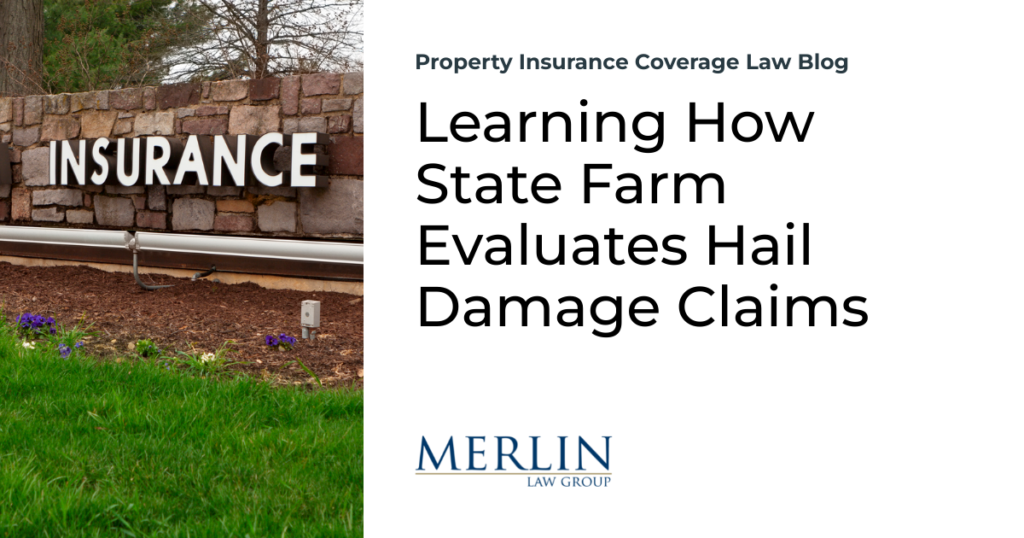Learning How State Farm Evaluates Hail Damage Claims

A number of attorneys, public adjusters, and roofers have been asking me questions about State Farm claims practice related to hail damage claims. Many insurers are not willing to fully explain to their customers how they instruct adjusters to handle claims—unlike the federal government, which published a manual regarding national flood insurance adjustments and invites the public to its claims certification training. As a result, it is often difficult to figure out what criteria an insurer uses to determine what is covered and what is owed. This is one problem regarding State Farm hail damage claims.
A blog posted by Micah Cartwright in our Oklahoma City office, Two Oklahoma Juries Find State Farm Acted in Bad Faith, noted two State Farm hail damage cases where State Farm was found guilty of improperly handling hail damage cases. Cartwright noted:
Importantly, the jury also heard testimony from a former State Farm adjuster with more than 13 years of experience adjusting property losses. She testified about a training initiative known as ‘Hail Focus.’ According to this adjuster, when Hail Focus was initiated, her direct supervisor and Team Manager stripped her of her ability to approve payment of roof replacements without first obtaining approval from the Team Manager. This meant she could not chalk areas of the roof she felt were damaged by hail until first speaking with the Team Manager; she could not approve payment for a roof replacement on-site during an inspection unless first obtaining approval from the Team Manager; and she could not tell property owners, contractors, or public adjusters of her decision to pay for the roof until she first obtained approval from the Team Manager. At trial, the Team Manager, who is notably now a Section Manager, denied knowledge of the Hail Focus initiative. The Section Manager provided similar trial testimony.
Digging a little deeper for those asking questions and readers of this blog, I found the policyholder’s response to State Farm’s motion for partial summary judgment1 worthy of study and encourage others to read it in its entirety. It stated in part,
There is a disturbing amount of evidence in this case and across an entire segment of State Farm’s claims department that saving money by turning a blind eye to their own hail recognition training became an end in itself. The truth revealed through an honest and thorough investigation would have dictated that Plaintiff’s claim be paid. Clearly, however, State Farm was not interested in being a ‘good neighbor’ to its insureds.
As demonstrated above, State Farm engaged in bad faith claim handling by: (1) drastically reducing the amount of training provided to field adjusters and sending a field adjuster who had never felt hail damage to conduct an inspection for hail…(2) stripping field adjusters of their ability to authorize roof replacements due to hail damage because State Farm was ‘paying for too many roof claims’ …(3) instructing field adjusters not to use chalk to circle spots they thought might be hail damage..(4) requiring field adjusters to send pictures of the roofs via text or email so Draper could decide whether or not to pay, a method which ignores State Farm’s training materials and the expection [sic] of Section Manager Sharon Arnold that hail damage identification must include a tactile examination..(5) purposefully omitting consultations with Draper from the claim file…and (6) using the term ‘wear and tear’ (which is not a covered cause of damage) to describe ‘old hail damage’…No one can honestly say this is a reasonable way to conduct an investigation.
The brief notes that State Farm has training manuals, PowerPoints, and videos that were part of its training. The problem was that this training would have proven a covered hail damage claim, and the new adjuster never went through that extensive training.
The partial deposition of the former State Farm adjuster is worthy of study as well.
The point is that when dealing with State Farm in the field, one should politely try to determine the experience and training of the person handling the file. I would strongly suggest that the authority of that person to determine coverage and pay the claim be enquired about. It appears from the hail damage claims that State Farm is providing little authority to the field claims adjusters. Then a desk managing adjuster who never speaks with the policyholder or goes to the loss site makes the decisions on claims.
Insurance companies have an obligation to service the product they sell when claims are made. “Getting it right” can only be done by “doing it right.” My hope is that State Farm would take an honest look at what is happening in its claims operations. A lot of customers rely on it “getting it right.”
Thought For The Day
A man must be big enough to admit his mistakes, smart enough to profit from them, and strong enough to correct them.
—John C. Maxwell
1 Bates v. State Farm Fire & Cas. Co., No 5:21-cv-00705 (W.D. Okla.).







